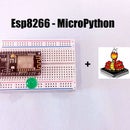Introduction: Digital Vibration Sensor Using LM358
Working with sensors makes electronics better and easy to work with, there are thousands of sensors to choose from and designing sensors would make for cool DIY projects.
This instructable will be a part of a series of Instructables in which I show you how to build sensors compatible with the most microcontroller you can find. In the last two Instructables, I showed you How to make a Tilt sensor and How to make a Touch sensor.
In this instructable, I will show you how to build a Vibration Sensor, which could be used as a part of a security system.
Step 1: Bill of Materials
Here is a list of what you need to get started with this instructable.
- LM358 IC
- 10K Pot
- LED
- 330 Ohm Resistor
- PCB
- Connecting Wires
- 5v Power Supply
- Breadboard
- Soldering Iron
- Soldering Wire
- Soldering Flux
- Multimeter (Optional)
Step 2: Circuit Sketch
The circuit is quite simple, this circuit uses an LM358 IC which is an Op-amp with an operating voltage range of 3v to 32v which is suitable to work with most microcontrollers. The circuit produces a digital output which gives a high pules each time a vibration has been detected.
Step 3: Vibration Switch
The vibration switch is built using un-insulated wire, you need to wind the wire on to a pen or any cylindrical surface. A resistor is placed in between the axis of the wire and when any vibration is detected the spring comes in contact of the wire and the circuit detects the contact and generates a signal turning on the LED.
Step 4: Sensitivity Calibration
The sensitivity of the circuit can be changed by varying the 10K pot, if the LED remains on even when no vibration is detected, you should change the pot with a screwdriver (plastic one recommends), until the LED turns off.
Step 5: TADAAA!! the Output
After you have tried it out on a breadboard you could build it on a PCB or as an arduino shield, for the spring you should use single strand wire. If you would like me to write a code for your micro-controller feel free to PM me.
In the next instructable I will show you how to build a photosensitive sensor.
If you have any queries, feel free to leave a comment below or PM me and I would try to help you.











